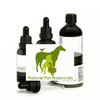Understanding the Difference
Bacteria and viruses are very different.
Bacteria are living organisms that can multiply on their own, while viruses need to live inside the body’s own cells to reproduce. Because of this, approaches that are traditionally described as “anti-microbial” are often associated with bacteria, while support for viruses is more about helping the body stay resilient and balanced.
Natural plant and mineral ingredients have long been valued in traditional wellness systems for their role in supporting vitality, balance, and the body’s natural defences during times of challenge.
Natural Antibiotics vs. Synthetic Antibiotics
Did you know that around 80% of the immune system is connected to the gut? This is why many traditions place importance on keeping the digestive system strong and supported — often through probiotics, herbs, and nourishing foods.
Synthetic Antibiotics
Modern antibiotics are designed with a focused purpose: to target and eliminate specific microbes. While effective, repeated use can sometimes disturb the body’s natural balance, especially in the gut where beneficial bacteria and vital minerals are involved in immunity and repair.
The Herbal Perspective
Herbal approaches look at the body in a holistic way. Instead of using one single active compound, medicinal plants contain a wide variety of natural constituents that:
- Work together in synergy
- Support the body’s own defenses
- Nourish and restore balance across different systems
This broader action was traditionally valued for helping to strengthen resilience and maintain long-term wellbeing.
Tradition Meets Science
Modern research is beginning to confirm what many herbalists and traditional healers have observed for generations: herbs can play an important role in supporting wellness, sometimes offering benefits that extend beyond the scope of single-compound drugs.
Balance Matters
Some pharmaceutical antibiotics, such as fluoroquinolones, have been linked in research to changes in the body’s mineral balance — particularly magnesium and calcium. By contrast, many herbal practices place emphasis on nourishment, restoration, and balance, helping the body maintain its natural rhythms.
* Natural pet botanicals are not intended to replace veterinary care or medication. Our formulas are offered as an alternative health support for your animal's condition and not as a cure.
SET OF
SET OF 3
1. Herbal Ease Breathe 250-1 100ml
2. Liposomal Vitamin C LIQUID 100ml
3. Fluid Balance 72-2 formula * Complimentary
Contains:
Formula 1. Medicinal Herbal Uses (Traditional and Historical Context)
CV 330-2
Baikal Skullcap has traditionally been associated with calmness, resilience, and renewal. Isatis has long been linked with inner strength, balance, and cleansing in cultural practices.
Kudzu Root is traditionally connected with grounding, adaptability, and restoration.
Red Root has been valued for its symbolic ties to vitality, circulation, and natural harmony.
Olive Leaf has a long history of association with balance, longevity, and renewal in Mediterranean traditions.
Pleurisy Root has been linked with endurance and clarity within traditional wellness systems. Purple Coneflower has been treasured for its symbolic connection to natural resilience and vitality.
Licorice Root is known in traditional practice as a harmonising plant associated with balance and inner steadiness.
Cordyceps has long been regarded as a symbol of strength, stamina, and renewal.
Andrographis has been valued in traditional cultures for its associations with inner strength, clarity, and natural balance.
Fenugreek has been linked throughout history with nourishment, warmth, and vitality.
Astragalus Root has been connected in traditional use with longevity, resilience, and sustained energy.
Pau d’Arco is recognised in cultural traditions for its association with strength, harmony, and natural protection.
Goldenseal has long been valued for its symbolic ties to renewal and inner balance.
Cryptolepis is traditionally associated with endurance, purification, and adaptability.
Coptis has been connected with cleansing, balance, and inner harmony in traditional wellness systems.
Juniper has a long history of being symbolically linked with purification, clarity, and vitality.
Sweet Annie has been celebrated for its associations with renewal, resilience, and seasonal balance.
Blue Flag has traditionally been connected with cleansing, transformation, and natural flow.
Usnea Barb has been regarded as a plant symbolising resilience and purity within cultural traditions.
Isatis Root has long been valued for its associations with cleansing, balance, and inner harmony.
Dong Ling Cao has been linked in traditional herbalism with renewal, clarity, and natural restoration.
in purified water & 30%-40% USP alc.
Bottle 2.
Liposomal Vitamin C liquid
Essential Nutrient — Vitamin C is one of the body’s most important vitamins, known for supporting overall wellbeing, energy, and balance. For generations, Vitamin C–rich foods like citrus fruits have been linked with vitality, brightness, and resilience.
Modern Liposomal Form — In liposomal form, Vitamin C is encased in tiny, natural spheres that help deliver it smoothly and gently through the body.
Liquid Convenience — Easy to take, mix, or measure, making daily support simple for the whole family.
Everyday Wellness — Often associated with skin health, energy, and renewal, Vitamin C is a daily companion in maintaining balance and vibrancy.
Note: This information is provided for general educational purposes. Vitamin C is part of a balanced lifestyle and diet.
Formula 3.
Leopard’s Bane (Apis Mell 12X, 1M) has long been associated in traditional practice with supporting balance in fluid retention and was symbolically connected with easing the body’s natural response to swelling or congestion. It was regarded as a plant reflecting resilience and renewal.
Hydrofluorocarbon (Fluoroform 200C) was traditionally connected with soothing persistent breathing discomforts, where it was linked in folklore with easing tightness and supporting clear airways. Its cultural use reflected associations with lightness and clarity.
Yarrow whole plant (Millefolium 12X, 1M) has a long-standing role in traditional herbalism as a plant of protection and vitality. It was often connected with strengthening the body, calming imbalances, and encouraging balance in circulation and breath.
Ferric Phosphate (Ferr Phos M) was traditionally valued for its symbolic connection with strength and vitality, being regarded as a supportive element in times of respiratory imbalance. It was linked in natural traditions with renewal and resilience.
Skunk (Mephitis 30C, 1M) carries strong folklore associations as a protective presence in nature, traditionally connected with easing difficult breathing patterns and paroxysms. It was seen symbolically as helping restore flow and rhythm in times of strain.
Kombe Tree Seed (Strophanthus Hispidus 12X, 200C) has a deep history in traditional African herbal practices, where it was linked to strengthening energy, supporting resilience of the heart, and aiding vitality when the body felt heavy or fatigued. It was also symbolically connected with balance and endurance.
Common Salt (Nat Mur 12X, 200X) has been historically revered for its balancing qualities, both physically and symbolically. In traditional practices, it was linked to equilibrium in body fluids and was seen as a grounding and harmonising mineral.
Wild Indigo Root (Baptisia Conf 200C) was traditionally associated with supporting breath and vitality, especially when calm rest was needed. Folklore describes it as helping those who struggled to find comfort when lying down, linking it symbolically to balance and ease.
Charcoal (Carbo Veg 1M) has been valued across traditions as a purifier and cleanser, symbolically tied to the restoration of breath and energy. It was associated with easing weakness, supporting oxygen flow, and providing grounding strength.
Tin (Stannum Met 30C, 1M) was traditionally regarded as a supportive mineral for breath and voice, connected in natural lore with resilience of the chest and airways. Symbolically, it represented endurance, strength, and clarity.
in 20% USP alc. in purified water.
Need more advice or have more questions? Contact us for a FREE consultation with one of our fully qualified practitioners.
These statements are for general wellbeing and educational purposes only. This product is not intended to diagnose, treat, or prevent any disease. Always seek veterinary or professional advice for specific health concerns.
DISCLAIMER
The statements made regarding these products have not been evaluated by the Food and Drug Administration. The efficacy of these products has not been confirmed by FDA-approved research. These products are not intended to diagnose, treat, cure or prevent any disease. All information presented here is not meant as a substitute for or alternative to information from your health care practitioners. The Federal Food, Drug, and Cosmetic Act require this notice.













